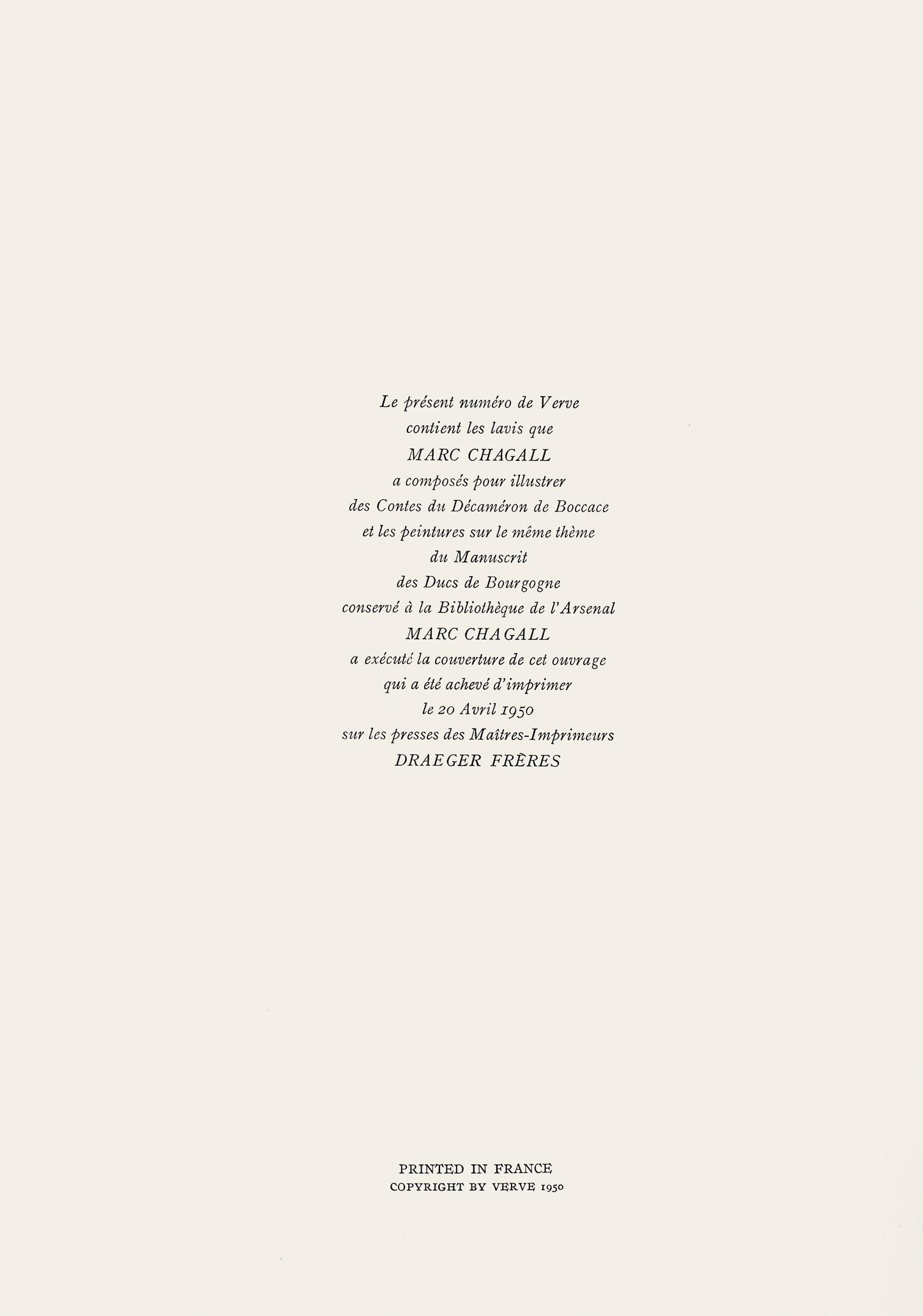Marc Chagall, Composition, Contes De Boccace, Verve: Revue Artistique Et Littraire, Lithograph
Marc Chagall, Composition, Contes De Boccace, Verve: Revue Artistique Et Littraire, Lithograph
Estimated Price: $775 - $950
Couldn't load pickup availability
Condition: Pre-Owned
Lithograph on vlin des Papeteries du Marais paper.
Unsigned and unnumbered.
Paper Size: 13.94 x 10.31 inches.
Excellent condition.
Notes: From the volume, Verve: Revue Artistique et Littraire, Vol.
VI, N 24, 1950.
Published by ditions de la revue Verve, Paris, under the direction of Triade, diteur, Paris; printed by Draeger Frres, Paris, April 20, 1950.
Excerpted from the volume (translated from French), This issue of Verve contains the washes that Marc Chagall composed to illustrate Tales of the Decameron of Boccaccio and paintings on the same theme of the Manuscript of the Dukes of Burgundy kept in the Arsenal Library.
Marc Chagall executed the cover of this work which was completed and printed on April 20, 1950 on the presses of the Matres-Imprimeurs, Draeger Frers.
Excerpted from Poppy Sfakianaki, La revue Verve (193760): Un tremplin pour la carrire de Triade dans les ditions dart, Journal of European Periodical Studies, 4.2 (Winter 2019), 7089, In 1937, Triade (1897-1983) met David Smart (1892-1952), the American publisher of Esquire magazine, who offered him to the opportunity to collaborate on the creation of 'the most beautiful magazine in the world'.
Smart recognized in Triade not only his ability as a publisher and knowledge of art history, but also his professional network and the name he made for himself in the Parisian art worldall crucial advantages for an editorial business.
Having had the commercial conviction that beauty "sells", Smart intended to address the American public, attracted to French art, including Modern art, and the myth of artistic life in Paris.
For his part, Triade saw the proposed collaboration as an opportunity for a foray into the American marketa powerful ally of modern art in France.
ditions de la Revue Verve was founded in November 1937, largely funded by Smart, and directed by Triade.
Verve: Revue Artistique et Littraire was a luxurious and ambitious art publication, published not only in French, but also in English in its early years, and distributed in Europe and the United States.
Its configuration was reminiscent of that of the French art journals Cahiers d'art, Minotaure, and Arts et mtiers graphiques, as well as that of the American art magazine, Coronet.
However, Verve was superior to the competition because of its copious iconography and high printing quality.
Its price varied between 60 and 150 francs (for double numbers) before the war, and between 120 and 350 francs during the war.
Given its high price, the magazine mainly targeted art dealers, collectors, bibliophiles and wealthy art lovers.
The exquisite aesthetics of the magazine was due to its editor-in-chief, Triade, who sought to develop a platform for dialogue between image and text, visual arts and literature.
The dominant factor of each issue remains its iconography, composed of reproductions of works by modern artists that Triade admired, and 'masters', mainly of the French tradition, alongside photos and miniatures of medieval manuscripts.
Triade undoubtedly realized with his magazine an idea expressed in 1934 according to which books served as an 'ideal museum' or an exhibition where all the artistic masterpieces are gathered, which Malraux developed later in Le Muse imaginaire (Geneva: Skira, 1947), parts of which will appeared in Verve.
During Second World War the periodicity of the journal changed, then irregular, and the less varied nature of the subjects treated.
Thus, the issues published during the War (as well as in 1945 and 1946) were devoted exclusively to the reproduction of medieval illuminations.
Finally, the special issues of the post-war period each present the recent production of a modern art painter.
Only numbers 8 (1940) and 27-28 (1952) were an exception with a more varied summary.
Verve's reception was positive as evidenced by several laudatory press articles throughout its run.
The success of the magazine, Triade's passion for modern art and medieval manuscripts, his admiration for the publications of Ambroise Vollard and Albert Skira, and his knowledge of the world of bibliophiles, soon led him to amplify his editorial activity.
In 1943, despite the practical difficulties imposed by the war, his first artist's book was published, written and illustrated by Georges Rouault.
Until 1975, Triade published ditions de la Revue Verve, nine books by modern artists, such as Henri Matisse, Pablo Picasso, Marc Chagall, Joan Mir, entirely composed (text and images) by the artists; seventeen books illustrated by recognized modern artists; an album of lithographs by Fernand Lger on Paris; two photographic albums by Henri Cartier-Bresson; two monographs on the artists Andr Beaudin and Francisco Bors; a luxurious series of reproductions of medieval illuminations; and, a series of portfolios on great French architecture. Ultimately, the comparative study of the journal and the editions of Verve: Revue Artistique et Littraire illustrates the importance of the tacit relational dynamic that results from the relations of collaboration and exchange of symbolic capital based on common perceptions and interests, as well as on feelings of mutual friendship and appreciation of actors in the art world who share a visual and bibliophilic culture and thus contribute to the success of the journal and the publishing house.
All items are carefully packed and shipped via insured courier services. Processing time: 1–3 business days.
Tracking details will be provided once shipped.
Read more of our
Shipping Policy.
All sales are final unless otherwise stated. Authenticity guaranteed. Please read full terms on our website before purchase.
Read more of our
Terms of Service.






Preview upcoming auctions and place a bid early.




































